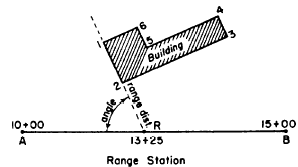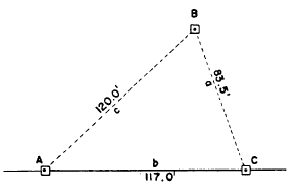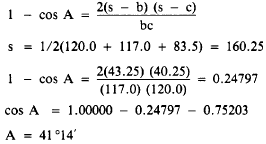|
Locating Points by Range Ties A points location can also be determined by means
of a RANGE TIE, using an angle and a

Figure 13-23.-Range ties.
distance. The method requires extra instrument manipulation
and should be used only when none of
the previous methods are satisfactory for use. Actually,
range ties establish not only the corner of
a structure but also the alignment of one of the
sides. In figure 13-23, assume that the building is
not visible from either A or B or that either or both
of the distances from A to B to a corner of the
building cannot be measured easily. With the instrument
set up at either A or B and the line AB
established, one member of the party moves along
AB until he reaches point R, which is the intersection
of line 1-2 extended. The instrument is
moved and set up on R, and the distance along the
line AB to R is measured. An angle measurement to
the building is made by using either A or
B as the backsight. The range distance, R-2, is
measured as well as the building dimensions.
SETTING ADJACENT POINTS
"To set a point adjacent to a traverse line" means
to establish the location of a point by following
given tie data. This tie data may be (1)
a perpendicular offset distance from a single specified
station, (2) angles from two stations, or (3)
an angle from one station and the distance from
another station.
Setting Points When Given
a
Perpendicular Offset Distance
To set a point when given an angle and its
distance
from a single station, you simply setup the
instrument at the station, turn the designated angle,
and chain the distance along the line of sight.
For perpendicular offset, the angle is 90. To
set a point when given a distance from each of
two stations, you can manage by using two

Figure 13-24.-Locating a point by
distances
from two stations.
tapes if each of the distances is less than a
full
tape length. To do so, you set the zero end of
the tapes on both stations, run out the tapes, and
match the distance mark on each tape to correspond
with the required distance from the stations.
When the tape is drawn taut, the point of
contact between the tapes will be over the location
of the desired point.
If one or both of the distances is greater than a
full tape length, you can determine direction of one
of the tie lines by correct triangle solution. For
example, in figure 13-24, you want to set Point
B 120.0 ft from station A and 83.5 ft from station
C. A and C are 117.0 ft apart. You can determine
the size of the angle at A by triangle solution
as follows:

To set point B, you can set up a transit at A, sight
on C, turn 4114 to the left, and measure off
120.0 ft on that line of sight. As a check, you can
measure BC to be sure it measures 83.5 ft.
|







